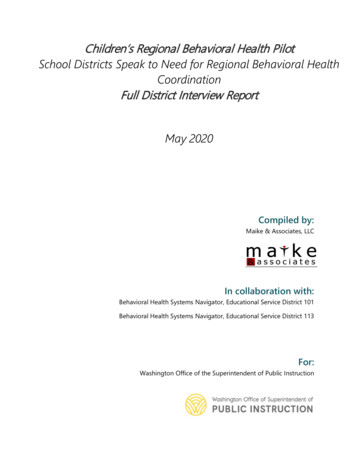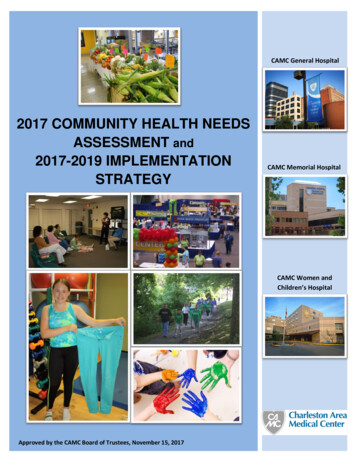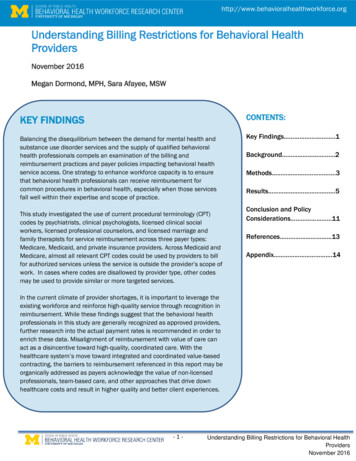
Transcription
BehavioralHealthIntegrationTreating thewhole personMARKETINSIGHTS The American Hospital Association, 2019
2Physical health andmental healthlive in the same body.We have to stop treatingthem as if they aretwo separate things.BehavioralHealthIntegrationHospital and health system executives knowthe behavioral health statistics, which includemental illness and substance use disorders.They see the tragedies in their own emergencydepartments (EDs) and can trace their roots,in part, to the lack of effective, integrated carefor these conditions. They understand how thedearth of coverage for and access to behavioralhealth services leads to poor health outcomesand higher health care costs.The question for many, though, is: What canwe do about it? As behavioral health researchis transforming the diagnosis and treatmentof these disorders, one answer is behavioralhealth integration. For hospitals and healthsystems, this means integrating behavioralhealth services into every aspect of patientcare, as well as coordinating and connectingwith community resources. It means treatingLEARN MORE Visit AHA.org/center
3DATAthe whole patient. It also means creating a continuum ofcare that reflects integration at each point in a patient’s journey to better health.4 Open behavioral health urgent care centers that are integratedinto urgent care centers that treat physical illnesses and injuries.5 For people with serious mental illness and substance-usedisorders, develop a behavioral health home option.1 in 5Number of U.S.adults sufferingThis Market Insights report from the AHA Center for Health Innovation offers options on how hospitals and health systemsTo help extend behavioral health access and care into thecan improve the availability and coordination of behavioralcommunity, hospitals and health systems can:health services in three areas of patient care.1 Collaborate with, joint venture with, or merge with a com-munity mental health center, certified community behavioralfrom any type ofbehavioral issuesOn the ED/inpatient side, hospitals and health systems can:health center, and/or a variety of other community-basedin 2017.1 Make behavioral health assessments routine for all patients,providers and stakeholders.Source: National Instituteof Mental Healtheither directly or through telemedicine services, and have aprocess in place for referral/treatment if needed.2 Use their electronic health record (EHR) systems to promptclinicians to assess all patients for behavioral health issues andensure that they are shared with and addressed by all providers.3 Open geriatric psychiatric (geropsych/complexity interven-2 Partner with other providers and community services toinvest in data integration and develop innovative servicedelivery models for patient-centered care.3 Make virtual behavioral health triage services available tocommunity groups, their members and federally qualifiedhealth centers.tion) units that are equipped to treat elderly patients‘ chronicphysical conditions in addition to their psychiatric needs, orThe net results of successfully integrating behavioral healthmed-psych units that specialize in treating patients with dualservices are better behavioral and physical health for patientsphysical and behavioral health diagnoses.and their communities and better fiscal health for all.On the outpatient side, hospitals and health systems can:1 Embed behavioral health clinicians in outpatient settings in acollaborative care model.2 Equip and educate affiliated primary care practices withevidence-based behavioral health screening and assessmenttools to use during each patient care visit.3 Document behavioral health screening, diagnosis and treat- ABOUT THIS REPORT: The AHA Center for Health Innovation developed this Market Insights report for hospital and health system executiveswho are working to integrate behavioral health into all care settings andcollaborate with their communities to improve health care delivery for better health outcomes. This report is based on information and insights froma number of sources, including interviews with hospital and health systemleaders and other health care experts, surveys of hospitals, and health carereports and research articles. A complete list of sources and other resources appears on Page 15 of this report. The AHA Center for Health Innovationthanks everyone for their contributions to this report.ment in EHRs to improve care coordination.LEARN MORE Visit AHA.org/center
4Creating One System of Care for Physical and Behavioral HealthDATA57.4%Percentage ofU.S. adults withbehavioral illnessin 2017 whodid not recievebehavioral healthservices.Source: National Instituteof Mental HealthPatients’ physical and behavioral health are inextricably entwined. Yet, historically, the health caresystem developed along two separate and distinctlines: one that treats physical illnesses and anotherthat treats behavioral health disorders. Efforts toend stigma, breakthroughs in brain science researchand parity for coverage are all part of the shift toremove the social and systemic barriers for thoseliving with behavioral health disorders.Percentage of hospitals reporting routineintegration of behavioral health services intothe following areas. Integration ranges fromco-located physical and behavioral providers,with some screening and treatment planning,to fully integrated care where behavioral andphysical health providers function as a trueteam in a shared practice.One patient. Two separate systems that attempt tocollaborate with each other at best and that don’ttalk to each other at worst. The result is a fragmented approach to caring for the whole patient who hasdifferent but related medical issues.Source: AHA Annual Survey, 201751%EmergencyservicesHospitals and health systems are working hard tochange that: to create one system of care with multiple entry points for patients with multiple medicalissues and to integrate behavioral health servicesinto every patient‘s experience when and wherepatients need them to effectively treat the wholepatient — both their physical and behavioral healthcare needs.Before a hospital or health system integrates behavioral health services into its operations, it shouldknow what integrated care means. Integratedcare is the systematic coordination of physical andbehavioral health care in acute care, primary care,emergency care, post-acute care, health homes andcommunity-based services, when needed. Integrated care goes beyond collaboration or coordinationbetween separate physical care and behavioral careproviders. The aim of integrated care is one systemof care for physical and behavioral health deliveredby the care team with different clinical specialtiesalong the entire care continuum.38%Primary careservices17%Extended care46%Acute inpatientservicesLEARN MORE Visit AHA.org/center
5Impact on Outcomes and CostClinical integration leads to better outcomes and lower costs. Many communities mistake financial integration for clinical integration. Financialintegration without clinical integration leads to reduced access, worseclinical outcomes, and generally greater overall total cost of care. Behavioral health carve-outs are also a challenge to integration. As healthcare is moving toward coordinated care, separation of funding places asignificant burden on practices, patients and families as they try to workbetween two systems.Behavioral health disorders have significant impact on individual andcommunity health, utilization of services and costs. Costs are 75%higher for people diagnosed with both behavioral health and other common chronic conditions than for those without a co-occurring behavioralhealth diagnosis. In Medicaid, the cost of care is two to three timeshigher for beneficiaries with co-occurring behavioral health and chronicconditions. Patients with behavioral health disorders also have significantly greater spending for general medical conditions than patientswithout a behavioral health disorder.Also, people with behavioral health disorders are more likely to have otherchronic medical conditions like asthma, diabetes, heart disease, high bloodpressure and stroke. In addition, those with physical health conditions (e.g.,asthma or diabetes) also report higher rates of substance-use disorders and“serious psychological distress.” As a result, those with behavioral healthdisorders — and co-occurring physical health conditions — are likely to usemore services like hospital and ED care, which increase costs.Increased access to behavioral health services is associated with improvedhealth outcomes, patient satisfaction and quality as well as lower overallhealth costs. Research demonstrates that models that incorporate behavioral health into other medical settings are associated with positive impactson behavioral and physical health outcomes as well as reductions in the useof acute services. To learn more about how increasing access to behavioralhealth services can improve outcomes and lower costs, download the AHAreport “TrendWatch: Increasing Access to Behavioral Health Care.”Integrating Behavioral Health into ED/Inpatient CareIn the Emergency Department2-3xIn Medicaid,the cost of careis two to threetimes higherfor beneficiarieswith co-occurring behavioralhealth andchronicconditions.As hospitals and health systems well know, the rate of ED visits is on therise. A 2018 study in JAMA Open Network found that nearly 30 percentof patients who visited a hospital ED had at least one behavioral healthdiagnosis. Also, the more severe the initial behavioral health diagnosis,the more frequently the same patient visited the ED the next year.Consequently, integration of physical and behavioral health services inthe ED can provide added value to the patients, providers and healthcare systems. That means making behavioral health clinicians availablein the ED to assess, evaluate and initiate/refer to treatment patientsregardless of the reason for which they came to the ED. Behavioralhealth clinicians can either personally assess and evaluate the patient,or consult with the ED physician who assessed the patient.Telebehavioral Health and Digital Tools in the EDExperts agree that, given the advancements in technology, every hospital and health system has expanded opportunities to provide access tobehavioral health services in the ED. For example, in areas with shortages of behavioral health professionals, hospitals and health systems canuse telehealth to integrate behavioral health into their routine emergencycare services.Some hospitals and health systems are experimenting with behavioral healthapps and kiosks in their EDs to assist patients and help doctors assess andevaluate patients’ behavioral health needs. After ED staff are able to rule out alife-threatening event, the patient answers survey questions that provide datato the practitioner using the self-help kiosk rather than waiting for a doctor todo the same thing. The kiosk sends the patient-reported information to the EDdoctor, who can discuss it with the patient during the ED visit.To learn more about the telehealth technologies and services availableto hospitals and health systems, download “Telehealth: A Path to VirtualIntegrated Care,” a recent Market Insights report from the AHA Center forHealth Innovation. If your organization is starting a telebehavioral healthprogram or strengthening an existing one, the AHA and the National Quality Forum have collaborated to produce “Redesigning Care: A How-to Guidefor Hospitals and Health Systems Seeking to Implement, Strengthen andSustain Telebehavioral Health,” a playbook which describes actionable strategies and interventions and links to a variety of other tools and resources.LEARN MORE Visit AHA.org/center
6In Units and on Patient FloorsA patient admitted to the hospital for a physical illness or injuryalso should undergo a behavioral health assessment and evaluation as a routine part of his or her treatment plan. Similar to doinga history and physical, checking a patient’s vital signs or dispensingmedications, a clinician can incorporate behavioral health questions,examinations, tests and treatments into the patient’s inpatient care. AtCedars-Sinai Medical Center, Los Angeles, 95% of patients admitted tothe hospital receive screening and evaluation for depression.URBAN HOSPITAL CASE STUDYBehavioral Health Assessment and Triage CenterTRUMAN MEDICAL CENTERS & OTHER AREA HOSPITALS Kansas City, Mo.DATA 1.7billionAnnual compliance costs incurred by inpatientpsychiatric facilities to meet threefederal regulatoryrequirementsaffecting patientevaluations, safecare settings andemergency department screeningsSource: NationalAssociation of BehavioralHealthcare, 2019A group of stakeholders in Kansas City — including representativesfrom law enforcement, hospitals, courts, city government, behavioral health clinics and homeless shelters — developed a uniquesolution to help those individuals with behavioral health disorderswho don’t require inpatient treatment but often end up in the EDor, worse, in jail. The group received funding from St.Louis-basedAscension, the city of Kansas City, area hospitalsand the Missouri Department of Mental Health,and opened the Kansas City Assessment and TriageCenter (KC-ATC) program in October 2016.important resource where local EDs can refer patients who do notneed inpatient treatment, but need linkage to outpatient services.This helps increase area ED capacity and the ability to treat morepatients, those who need inpatient behavioral health services andthose who need other inpatient medical care, as well as improvesthe efficiency of ED operations.” Individuals with mental health and substance usedisorders — who don’t meet inpatient criteria — arereferred by approved EDs and Kansas City police officers to the KC-ATC, where they can be triaged andassessed. Individuals remain at the center voluntarily, and no walk-ins are allowed. The KC-ATC is staffedby a multidisciplinary team that includes registerednurses, caseworkers, mental health technicians,licensed social workers and advanced nurse practitioners who collaborate with a psychiatrist. Currently,18 slots are available at the center — nine in theSobering Unit for those currently under the influenceof a substance and nine in the Stabilization Unit forthose with a primary behavioral health issue.“The KC-ATC has already had a significant impact forthe citizens of Kansas City with acute mental healthor substance abuse problems,” says Kevin O’Rourke,M.D., director of clinical operations, emergencydepartment, Truman Medical Centers. “It is anLEARN MORE Visit AHA.org/center
7CRITICAL ACCESS HOSPITAL CASE STUDYP R O T IPUse EHRsystemto promptclinicians toassess andevaluate everypatient for behavioral healthissues andbe capable ofrecording andsharing thatinformationwith all otherprovidersalong thepatient’scontinuumof care.Modules within EHR systems or handheld clinical decision-support tools can prompt clinicians to routinely collectthat information and document the behavioral health servicesprovided in patients’ health records. Given the interconnection between physical and mental health, those initialassessments and evaluations often uncover a comorbid behavioral health disorder that can start being treated while thepatient is in the hospital. This is especially important becausedepression among hospitalized patients is often unrecognized, undiagnosed and, therefore, untreated. Hospitalizationrepresents an unrecognized opportunity to optimize bothmental and physical health outcomes.To treat such comorbid patients, some hospitals andhealth systems are opening geropsych units that specializein caring for elderly patients with behavioral health issuesthat are exacerbating their physical health symptoms.Others are opening med-psych units for patients withacute dual complex physical and behavioral health diagnoses. Such units are staffed by multidisciplinary teamsof caregivers that include behavioral health clinicians andspecialists who develop and execute one comprehensivecare plan that covers both a patient’s mental/substanceuse disorder and physical care needs.Experts also recommend that behavioral health interventions start before surgery or treatment for physical careneeds, not just after discharge. By treating the whole patient, they will be better prepared for surgery or treatmentand for their recovery after leaving the hospital.Hospitals and health systems that successfully integratebehavioral health services into their inpatient operationscan enjoy a number of clinical, operational and financialbenefits, including: Improved clinical outcomes. Fewer patients returning to the ED. Fewer inpatient readmissions. Improved ED patient throughput. Shorter lengths of stay. Lower costs in general and under value-based reimbursement contracts. Geriatric Acute Behavioral Health ProgramCOTTAGE HOSPITAL New Woodsville, N.H.Serving a large region of New Hampshire and Vermont, Cottage Hospital is a criticalaccess hospital with 25 acute care beds. In October 2016, the 10-bed Ray of HopeGeriatric Behavioral Health unit opened at Cottage Hospital. Specifically designedfor older patients with persistent or late-onset mental illnesses, the interdisciplinaryteam, comprising a psychiatrist, gerontologists, registered nurses, licensed practicalnurses, licensed nursing assistants, social workers and recreational therapists,provides a holistic patient-centered approach that attends to the mental, physicaland psychosocial aspects of the individual.Patients come to Ray of Hope via Cottage Hospital’s ED as well as other hospitals’EDs, long-term care facilities, primary care physician practices and other settings.“They often come to us because something has changed recently in their mood orbehavior,” says Chief Nursing Officer Holly McCormack. “People in this age groupmay be seeing a lot of changes in their lives, such as family members and friendspassing away, or maybe they’re moving into a new living situation. Often, they havecomorbidities. Anxiety and depression come up a lot, along with suicidal ideation.”Length of stay is usually between 15 and 20 days, as medication adjustments taketime when patients are being treated for multiple conditions. Specialists in caringfor older populations, Ray of Hope behavioral health program caregivers work withfamilies to put plans in place that allow approximately 40 percent of the patients tobe discharged back to their homes. LEARN MORE Visit AHA.org/center
8Integrating Behavioral Health into Outpatient CareDATAIf patients with behavioral health issues reach the hospital ED or aninpatient unit, it often means that their issues weren’t effectivelymanaged in an outpatient or less restrictive setting of care.For hospitals and health systems, integrating behavioral healthservices into the daily operations of their affiliated primary carepractices is a must, according to experts. That means supportingthe affiliated PCPs and pediatricians with evidence-based, standardPercentage of rural ized behavioral health screening and assessment tools to use witheach patient visit. Doctors, nurses or other trained staff screen andadults surveyedassess patients during their initial conversation and exam similar towho would be comtaking a blood pressure reading. It also means teaching PCPs howfortable speakingto effectively use those tools and educating them on what to dowith the information from those screenings and assessments. Into their primaryaddition, hospitals and health systems need to establish a continucare doctor aboutum of services to which patients can be referred.behavioral health78%issuesSource: American FarmBureau Federation, 2019From there, the clinician can treat the patient during their visit, referthe patient to a behavioral health specialist for further evaluationand treatment, send the patient to the ED, admit the patient to his or heraffiliated hospital if the patient needs emergency or immediate acutecare services, or refer the patient to community-based services whenavailable.When behavioral health competencies aren’t physically available on-site,PCPs, particularly those in geographic markets with few psychiatrists orother behavioral health specialists, may be able to access consultationsvia telehealth technologies. Remote specialists can consult virtually withthem about a patient or connect with the patient virtually [see below formost common models].Other hospitals and health systems are taking further steps by openingbehavioral health urgent care centers. Some centers are stand-alone,while others are adjacent to or co-located with existing urgent carecenters.Whether PCPs with behavioral health specialists on staff, PCPs withtelepsychiatry capabilities or behavioral health urgent care centers, theLeading Outpatient Behavioral Health Integration ModelsSome hospitals and health systems are developing formal behavioral health integration models fortheir PCPs. Below are three typical models from most integrated to least integrated.MODEL 1Including a behavioralhealth specialist in thepractice as a regular partof the care team.MODEL 2Co-locating a behavioral health practice inthe same medical officebuilding as the PCP.MODEL 3Establishing an affiliationwith a behavioral healthpractice in a physicallyseparate location.LEARN MORE Visit AHA.org/center
9clinical goal remains the same: Get patients the behavioral health andsubstance use disorder services they need before their conditionsworsen.Bi-directional integration: Behavioral health homesfor people with serious mental illnessPeople with serious mental illness (SMI) — defined as a mentaldisorder resulting in serious functional impairment that substantiallyinterferes with one or more major life activities, such as schizophreniaor bipolar disorders — are at high risk for multiple chronic disorders.For these patients, the integration model shifts. Instead of integratingbehavioral health into primary care, primary care and specialty services are integrated into a behavioral health home model. Behavioralhealth homes are patient-centered medical homes designed for thespecific needs of people with SMI.DATA57%Percentage ofphysicians andnurse practitioners surveyedbetween 2015 and2018 who said thatthey didn’t feel adequately preparedto screen patientsfor behavioralhealth disorders orsubstance useSource: American FarmBureau FederationBehavioral health home models can improve outcomes for peoplewith SMI, as well as patient engagement in care. Research has shownthat people living with SMI have a lifespan that is 14-32 years shorterthan that of the general population. According to the National Instituteof Mental Health, 85% of the premature deaths were due to largelypreventable conditions such as high blood pressure, high cholesterol, diabetes and heart disease. One study reported that patients inbehavioral health homes increased their use of outpatient physicalhealth services by 36%. More importantly, utilization of the model isleading to fewer ED visits and fewer admissions, and helping peopleto live healthier lives. To address the physical health care needs of theunderserved, at-risk group of people with SMI, providers have severaloptions on how to structure the behavioral health home, depending onthe resources available.1 In-house model: The health system supplies and owns the complete array of primary care and specialty behavioral health services.2 Co-located partnership model. The health system arranges forhealth care providers to supply primary care services on-site in behavioral health settings. This approach may be suitable for midsize organizations that have the infrastructure to develop partnerships but lack theresources and economies of scale to develop an in-house model.3 Facilitated referral model. The health system conducts physicalhealth screenings, links clients to primary care providers in the community and facilitates communication and coordination between thebehavioral health provider and other health providers. This structureworks for smaller providers and may also serve as a transitional modelfor those planning co-located partnership or in-house models in thefuture. ACADEMIC MEDICAL CENTER CASE STUDYPCPs Leverage App for Behavioral HealthMONTEFIORE HEALTH SYSTEMHudson Valley, N.Y. The Bronx, Westchester andIn 2015, Montefiore Health System in New York City began implementing a program using the Collaborative Care Model (CoCM) to betterserve its large population of low-income and minority patients withsignificant medical and behavioral health comorbidity and socio-economic challenges. A grant from the Centers for Medicare & MedicaidServices’ Innovation Center helped Montefiore design, implement andsustain the CoCM to increase the availability and quality of behavioralservices and test innovative reimbursement methods.At the same time, Montefiore began looking for ways to leveragedigital tools, developing a behavioral health registry in the EHR andpiloting a smartphone application developed by Valera Health, toenhance care management capabilities and allow care managersto increase the number of patients with whom they interact. Theprogram has helped the health system improve care for both pediatric and adult patients with behavioral health conditions, includingdepression, post-traumatic stress disorder, general anxiety disorder,panic disorder and alcohol use disorder.Under Montefiore’s CoCM clinical initiative, PCPs who treat patients with behavioral health are supported by a behavioral healthcare manager and psychiatric consultant. The behavioral healthmanager provides brief behavioral interventions, supports treatment initiatives delivered by the PCP and coordinates care withthe PCP and psychiatric consultantusing a shared registry to review andmonitor the progress of patients.A licensed clinical social worker orpsychologist is also part of the teamand provides diagnostic confirmationand short-term psychotherapy whenappropriate. Since adoption, the apphas improved the effectiveness andefficiency of the CoCM by allowingbehavioral health care managers towork with higher caseloads whilemaintaining key elemnts of theCoCM aimed at improving treatmentoutcomes. LEARN MORE Visit AHA.org/center
10Integrating Behavioral Health into Community OutreachHospitals’ relationships with community-based organizations have madethem central to addressing community-wide behavioral health careneeds. Similar to the prevention and early detection of physical disorders, prevention and early detection of behavioral health disorders leadto better health outcomes for patients, better health for communitiesand lower overall health care costs.It follows then, experts say, that hospitals and health systems that takea behavioral health integration approach to care delivery have seenimproved outcomes and reduced costs, as evidenced by the continuedsuccess of Montefiore’s Pioneer ACO program.One of the most effective ways for hospitals and health systems todetermine the needs of their communities is to partner with community groups to conduct formal and regular behavioral health communityneeds assessments (see graphic below).Based on the assessments, hospitals and health systems might partnerwith one or more groups to offer behavioral health educational programsand conduct regular behavioral health screenings as part of existingcommunity-based screening programs, such as those for cardiovasculardisease or diabetes.Hospitals and health systems also can make virtual behavioral healthtriage services available to community groups that, in turn, can makethem accessible to their members who are more comfortable discussing their behavioral health concerns virtually than face-to-face with aclinician.When the programs and screenings identify community members atrisk for a behavioral health disorder, hospitals and health systems canconnect those members with the appropriate level of behavioral healthservices in the continuum of care before those issues become acute.Ideally, hospitals and health systems would be able to integrate theirpopulation health data-collection mechanisms with those used by community groups and unaffiliated providers to identify at-risk patients andtarget them for early and appropriate behavioral health interventions.Community groups to partner with on behavioral health initiatives Churches Certified communitybehavioral health clinics Employers Homeless shelters Other faith-based organizations Schools Judicial system Community advocacy groups Community mental health centers Federally qualified health centers Law enforcement agencies Other health care providers Social service agenciesLEARN MORE Visit AHA.org/center
11HEALTH SYSTEM CASE STUDYDATA2,538Number ofcommunitymental healthcenters inoperationacross thecountry in2017Source: SubstanceAbuse and Mental HealthServices AdministrationP R O TIPPartner withmajor employers in yourcommunityto launch anongoing behavioral healthstigma-reduction programfor theiremployeesFor behavioral health services in thecommunity to be successful, executiveleaders need to start by setting the tonewithin the health system. People withbehavioral health conditions need just asmuch access to services as someone withcancer or heart disease. In nearly all cases,behavioral health services are break-evenor are a service line that runs in the red.It’s imperative to collaborate on behavioralhealth services with other hospitals in thesame market to be able to identify servicedelivery gaps and then augment existingservices. Working alone will not resultin a better outcome and likely will drainsubstantial resources for other communityneeds. The most beneficial and costeffective solution is to connect with thesepatients long before they end up in the EDor in crisis.Partnerships with community mentalhealth centers (CMHCs) are integral toproviding behav
Telebehavioral Health and Digital Tools in the ED Experts agree that, given the advancements in technology, every hospi-tal and health system has expanded opportunities to provide access to behavioral health services in the ED. For example, in areas with shortag-es of behavioral health professionals, hospitals and health systems can










